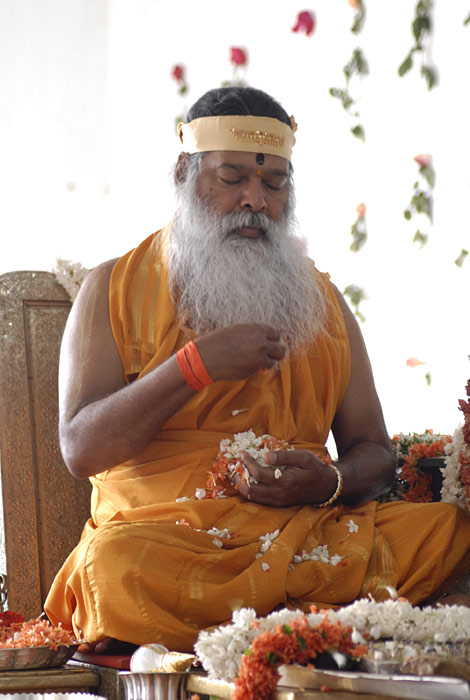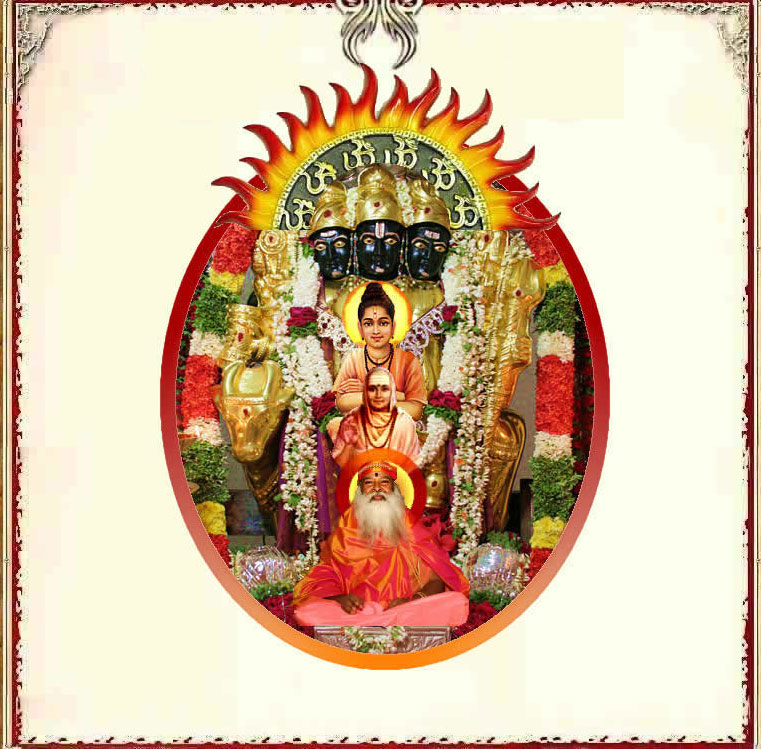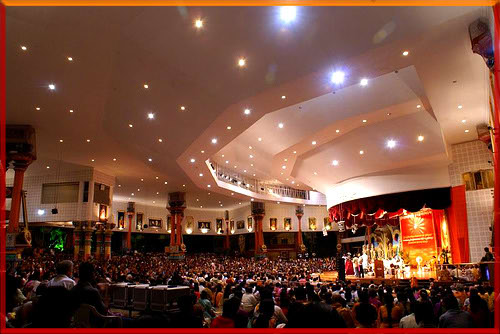His Holiness Sri Ganapathy Sachchidananda Swamiji, Mysore, India
 Some say Sri Swamiji is an Avataar, Yogi, Man of Miracles, Healer, Doctor, etc. Each person has his own way of looking at Him. When one would see him, he would experience Swamiji by himself.
Some say Sri Swamiji is an Avataar, Yogi, Man of Miracles, Healer, Doctor, etc. Each person has his own way of looking at Him. When one would see him, he would experience Swamiji by himself.
As one of the rare living Avataras… He is the Pontiff of Avadhoota Datta Peetham at Sri Ganapathy Sachchidananda Ashrama in Mysore, India. His Holiness Sri Sri Ganapathy Sachchidananda Swamiji one of the greatest spiritual leaders of the present day is an asset to India and the world at large. He is an incarnation of the Great Cosmic Power. Revival of culture, reformation of society and establishing peace and happiness among mankind and transforming into godly men is his mission.
He was born fully realised in command of the
eight Mahasiddhis and is a Guru in the Dattatreya Avadhoota lineage.
His methods include: establishing Dharma and Bhakti by singing devotional Hymns, by reciting the names of the Lord Almighty and inculcating the masses by instilling into them love of God through chorus singing of Bhajans and listening to his Meditation-Music. Sri Swamiji is renowned for His Healing and Meditation music and He is considered a divine guide who cultivates the ancient Vedic traditions.
The Actual Birth
Sri Swamiji was born at Mekedatu in southern India on May 26, 1942. A Muslim Saint (Fakir) had given a prediction to His parents that their child would have supreme power, wisdom and knowledge and was destined to uplift mankind.
The Actual Birth occurred on a rock in the Kaveri river. His mother ‘Jaya Lakshmi’ was in deep meditation and the child was born covered with holy ash. The child was named ‘Satyanarayana’. His mother, whom Swamiji calls His first Guru, initiated Him into spiritual life before her passing in 1951. Satyanarayana completed His education like other children, but found school had nothing to offer Him. He was endowed at birth with great knowledge and power. Even as a child, he organized satsangs and taught bhajans to His friends, and performed “siddhis” to entertain them, such as turning neem leaves sweet.
For some time He performed various mundane jobs to earn a living, such as school teacher and postal worker. All along, however, he had been serving his fellow humans, helping them with their problems. Through his miraculous powers He was able to understand their situations, knowing their past, present , and future and helped them to overcome difficulties. Some of them became his first disciples who were soon to be followed by more. He sang bhajans and kirtans for them and started giving yoga classes in small village huts or on river banks, while he was wandering the countryside as a monk. He acquired a following which demanded all of His time an attention.
In 1966 He moved to the present site of the Mysore Ashram, which in the early days was only a straw hut in a field. It was there at Mysore that He became Sri Ganapathy Sachchidananda Swamiji at the age of 22 . Since then Sri Swamiji has been helping people in His unique way. People come to Him for help with their worldly affairs, or to become healed of physical afflictions, or for guidance in their spiritual practice. Many come to hear His beautiful and powerful songs, which draw the heart and mind to God or to celebrate the special Hindu holidays in the old vedic traditions.
Sri Swamiji honours all religions and teaches that it’s possible to reach God by many paths. “It is of primary importance to attune with God through prayer, worship and the chanting of God’s holy names”. “Then God Himself will give you good guidance” says Sri Swamiji.

The Mysore Ashram
The Ashram in Mysore, India, has grown over years to an impressive size and encompasses many aspects of the spiritual life. There one can study Yoga, the Vedas and Sanskrit. There is a Universal Prayer Hall where traditional Pujas and Homas (special Hindu worship services) are performed. As Sri Swamiji propagates the teaching of Dattatreya Avadhoota, a Datta Temple has been constructed. Dattatreya represents the eternal teacher, the Manifestation of the Triple Principle of Sat (Existence), Chit (Knowledge) and Ananda (Bliss).
At the Mysore ashram, Swamiji offers daily Sri Chakra Puja and Ganapathi Homa. Although this great yogi practices Hindu rituals, He embraces everyone – the agnostic, the atheist, the disbeliever, as well as those of any faith. All are welcome at the ashram. Sri Swamiji stresses that His teachings and the Vedas are really universal. The Ashrama is open to all people of all religions and on special Hindu holidays, like Shivaratri and Navaratri, thousands of devotees from all over the globe come to the Universal Prayer Hall.
Nada Mantapa
Nada Mantapa is a testimony to Pujya Sri Swamiji’s dedication, attachment and love for Music. The Nada Mantapa auditorium is in the shape of a palm tree leaf (frond).

Unique Features of the Nada Mantapa
The world’s first and only Sapta Swara Devata Mantapam: This Mantapa has deities of the Godheads representing the seven musical notes. Sa-Agni, Ri-Brahma, Ga-Saraswati, Ma-Parameshwara, Pa-Maha Vishnu, Da-Maha Ganapati and Ni-Surya Narayana.
Twenty-two gigantic Tamburas have been sculpted and positioned gracefully against the 22 pillars of the auditorium. These 22 Tamburas represent the 22 Shrutis mentioned in the Sangeeta Shastra.
The entrance of the auditorium has the sculpted deities of godheads connected with music – Chaitanya Maha Prabhu, Narada Muni, Garuda, Vishwaksena, Anjaneya, Tumburu, Hayagreeva, Nandi, Bhringi and Ganapati. The porch is colourfully decorated in Tamilnadu style.
The auditorium is equipped with state of the art sound (Bose Corporation of USA), lighting and theatrical systems.
The staggered seating system will hold more than 3,500 people in this sacred auditorium, making it one of the largest performing theatres in India. The vast stage measures upto 2150 sq.ft. The seats are laid out in a radial pattern such that they fall within an angle of 140 degrees from the position of the performer.
The walls are decorated with huge portraits of eminent music composers of the past. A special lighting system will illuminate the portrait of the particular composer whenever his composition is sung or played. For example, when the composition, Samaja Varagamana – of Saint Tyagaraja is played or sung, the lights in front of the portrait of Tyagaraja will automatically light up
Datta Centres
Sri Swamiji has inspired more then 50 centers in India and abroad and has build 18 new Dattatreya temples in India. Recently, He has been asked by Indian religious leaders to take care of five other ancient Dattatreya temples. Regular worship, including homas, pujas, classes in Hatha and Kriya Yoga, Sanskrit and the Vedas.
Social Projects
In addition to intense spiritual activity, ashram life is also devoted to helping the poor. It is a tradition that all Mysore ashram visitors are fed free and food is distributed to the needy on a regular basis. Also, the Ashram runs two local schools, provides free medical services and conducts free eye camps.